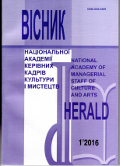СВІТЛО І ТЕМРЯВА ЯК МАНІФЕСТАНТИ ЕТИЧНИХ ЦІННОСТЕЙ У НОВОМУ ЗАВІТІ
Light and darkness as demonstrators of ethical values in the New Testament
Author(s): Maryna Oleksandrivna ChumachenkoSubject(s): Metaphysics, Semiology, Ethics / Practical Philosophy, Cultural Anthropology / Ethnology, Biblical studies
Published by: Національна академія керівних кадрів культури і мистецтв
Keywords: light; darkness; axiology; numinous continuum; sacral anthropology;
Summary/Abstract: Role of light and darkness as axiological constants from the ethical part of the New Testament was considered in the Article. Special aspects of light/darkness presentation as instruments of sacralization and active social and cultural regulators and correlators of numinous space were highlighted. Semantic spectrum of light and darkness image, binary of these terms and variability of their transformations were indicated. Functions of light and darkness as elements of sacral anthropology in religious reflection being special cultural practice were considered.Rationale involves understanding through cultural and philosophical exegesis of religious art mechanisms, among which axiological constants have acquired special meaning – light and darkness as specific modulants of the Christian culture meaning. Determination of the light and darkness role in sacral mechanism of cultural and Christian art organically combining with mythopoetics shall integrate basic definitions of the Christian religious doctrine to the entire belief system of the society. The Bible includes extensive system of cultural, axiological, symbolic and iconic, metaphoric elements wherein light/darkness are the instruments of sacralization and legitimation of the model of social and Christian regulation.Purpose of the Article is to understand axiological capacity of light and darkness as demonstrators of ethical values in the New Testament. Thereunder, the following tasks were assigned: firstly, to determine dialectics of light and darkness coexistence and special aspects of their presentation as axiological constructors and axiological demonstrators from the ethical part of the New Testament; secondly, to analyze semantic meaning of light and darkness in texts of the New Testament; thirdly, to determine morphologic function of light and darkness semantics and their role in numinous space creation and change.Light and darkness in the Biblical ontological dimension are hierophany "communication" elements moving a human closer to/away from God whereby violate demarcation between sacral and secular space. Creation of social and cultural religious space is legitimized by light as an active regulator of secular/sacral communication portal. Axiological code of light is based on mythopoetic, iconic and symbolic, ontological and transcendental elements for demonstration of non-material nature of the God. Light is an imperative with the help of which involvement in the numinous dimension is established. Such involvement is expressed in grace offering to the God’s light and is symbolic and presentation basis for axiological and cultural polycode of the Christianity predicates: firstly, modeling human’s behavior by translation of sacral intentions – ethical and Christian regulators; secondly, light sacral support – axiological attributes of numinous space where a man of God is located; thirdly, a human as a cofounder of cultural and religious space of the Christian light; fourthly, light as a semantic construct of axiological, symbolic and iconic, epithet and metaphoric and mythopoetic dimensions of the Christianity.Using a symbol of light for determination of the God’s nature extrapolates poetics of symbolism into theological field. Representatives of sacral sanctions, God’s presence – axiological "derivatives" of light: luminary (in the Bible – the God’s word, the God’s law); in hagiographical literature and Bible – luminary of the Church, saints; Gospel; angels; guardian angels, etc. Ontological modes of light and darkness are also axiological actions – active and/or passive. Light is always active: in fighting against infernal powers, in the Christianity truth enlargement, God’s men rescue and support. Darkness, in exchange, is passive, it represents absence of light. Correlation of the darkness qualitative characteristics – from essence expression in light antipode to fighting against it, bringing to sacral sanctions and punishment of innocents, demonstrates its activity.Therefore, the research of light and darkness axiological constructors as demonstrators of the New Testament ethical values, rethinking thereof in the cultural dimension allows determining their influence on creation of particularities of numinous continuum of the Christian world. Light and darkness are axiological representatives of sacral opposition to bipolar world order, active semantic and morphologic joining elements between sacral and secular space. Performing regulation function of God – human, human – God communication channel, light and darkness introduce topos – sacral involvement and axiological action, to cultural and religious reflection. Light and darkness as factors of social regulation – metaphoric, mythopoetic elements of sacral anthropology, correlators of ethical and humanistic units, modulators and transformers of ontological field, specific "axiological templates" of the Christian ascetic culture, orient coordinate of the religious genesis – participation with the Christ. Value forming potential of light and darkness is a guarantee of polycode of semantic and multiple modification of the spiritual – hierophany.
Journal: Вісник Національної академії керівних кадрів культури і мистецтв
- Issue Year: 2016
- Issue No: 1
- Page Range: 54-59
- Page Count: 6
- Language: Ukrainian

